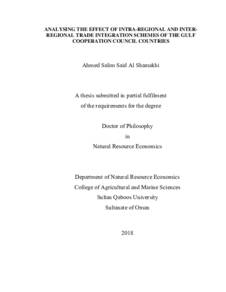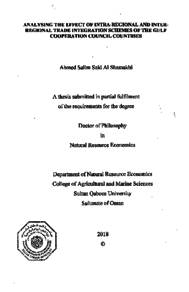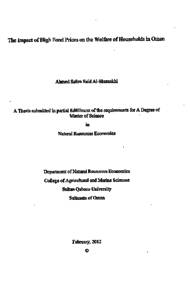Document
.Analysing the effect of intra-regional and inter-regional trade integration schemes of the gulf cooperation council countries
Publisher
جامعة السلطان قابوس
Gregorian
2018
Language
English
Subject
English abstract
The process of trade liberalization in the Arab region has been shaped by the accession of many countries to the World Trade Organization and the emergence of various regional trade integration arrangements involving countries within the region as well as countries outside the region. The Gulf Cooperation Council (GCC) countries has been engaged individually with other Arab countries in forming the Greater Arab Free Trade (GAFTA) and with other countries outside the Arab region (USA, Singapore, EU).
The overall objective of this thesis is to investigate whether the effect of promoting and deepening trade integration with the rest of GAFTA sub-regions would be a better incentive for the GCC countries than engaging in preferential trade arrangements with well-established trade blocs outside the region, such as the EU. Specifically, four types of integration schemes of the GCC were analyzed involving the deepening of GCC integration with GAFTA sub-regions and the formation of Free Trade Area with the European Union. The study gives special consideration to the prevalence and the effect of Non-Tariff Barriers (NTBs) and trade facilitation measures in the region and provides estimates of their Ad-Valorem Equivalents for agricultural and non-agricultural commodity aggregates. A computable general equilibrium (CGE) approach was employed by using GTAP program to assess the economy-wide and sectoral effects of the various integration schemes of the GCC countries. The GTAP database was aggregated into 29 regions and 34 sectors and the data was updated to include the weighted AVEs and projected to the year 2016, which will serve as a base year for the simulations The GTAP simulations results indicate that the GCC gain from trade liberalization with the rest of GAFTA subgroups and with the European Union is limited unless complemented with trade facilitation measures (TF). Among the four scenarios, scenarios II (full completion of GAFTA with trade facilitation) leads to the highest welfare gain for the GCC countries, whilst for the other scenarios, the gain is either very small or zero. Within GAFTA, the Maghreb and the Mashreq countries GDP gain more (1.77% and 1.47% respectively) than the GCC, reflecting the initial higher level of protection as well as higher inefficiency levels in trade logistics and customs clearance procedures. Results also showed that the effect of GCC establishing FTA with EU will lead to a negative welfare effect for all GCC countries. This implies that for the GCC, an additional FTA outside the region is not necessarily welfare-enhancing.
The GAFTA completion scenario complemented with TF (Scenario II) shows the highest trade effects as reflected in the intensification of exports and imports of GAFTA subgroups. The effect is slightly higher for the Mashreq and North Africa sub-groups due to the initial level of non-tariff measures compared to the GCC region. The same scenario showed significant increases in GAFTA intra-regional trade, where both the Mashreq and
Maghreb sub-regions significantly increases their exports towards the GCC countries. Gas and coal products, Agri-food products such as dairy, meat and vegetable oil witnessed the highest increase in export within the Maghreb sub-region; the food sector performed relatively better than other sectors in terms of exports. The GCC countries also were able to benefit from GAFTA completion and trade facilitation scenario II. However, the export sector performance is relatively modest compared to other GAFTA subgroups. The exports are mainly driven by oil and food commodities like, wheat and dairy products, destined mostly to North Africa region. Similarly, the trade within the GCC region also improved especially for the gas and food sectors. Commodities that showed significant sales increase are rice, oilseeds, meats and vegetable oil. The other sectors that showed potential for strong positive increase are coal, chemicals, metals, and textile.
The main policy implications drawn from this study are as follows: Firstly, the GCC should go for deeper regional integration rather than integrating with more developed trade blocs. Secondly, the GCC should push for application of trade facilitation measures among GAFTA members. Thirdly, the GCC and other GAFTA subgroups should start implementing the WTO trade facilitation agreement.
Member of
Resource URL
Category
Theses and Dissertations




